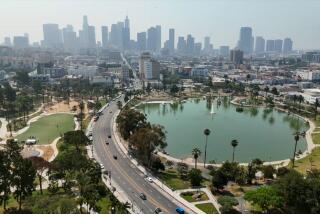Syracuse, N.Y., and other U.S. cities are rethinking urban freeways
- Share via
Reporting from SYRACUSE, N.Y. — Half a century ago, engineers constructed a massive elevated highway through the center of this industrial city to quickly funnel traffic from downtown to the growing suburbs to the north.
Now, Van Robinson wants to make it disappear.
“We need to tear this thing down,” he said, standing on a street corner near Interstate 81, as some of the 95,000 vehicles that pass over this highway every day zoomed noisily overhead. “Now is the time to do something that will make our great-great-grandchildren say, ‘Hey, those were smart people.’”
Federal and state transportation officials say the highway, completed in 1969, is reaching the end of its useful life, something that is painfully obvious to anyone who travels above or below the roadway. The green metal that holds up the elevated freeway is rusting, the pavement is cracking and the railing containing its four lanes is missing in places.
What exactly to do with the road is something that Syracuse hasn’t yet figured out.
Plans have been proposed to build a new elevated freeway, to sink the highway below street level but still out in the open, or to bore a tunnel under the city, all of which the New York Department of Transportation is considering in a series of public meetings.
But Robinson, who is 75 and the president of the city’s Common Council, is causing the most controversy with the plan he’s pushing. He wants to demolish the 1.4 miles of highway that cuts through the middle of Syracuse and route the traffic through surface streets, creating a grand boulevard where the highway once stood, complete with stores, homes and a more walkable vibe.
It’s an idea that’s catching on as cities across America try to revitalize downtowns decimated by highway construction and the departure of industry. Baltimore, Milwaukee and San Francisco have all torn down urban freeways and built parks or walkable areas in their place.
“It seems like it’s gaining popularity,” said Ted Shelton, a professor of architecture at the University of Tennessee who studies urban highway removal. “For so long, we’ve thought when a highway gets to capacity, we need to add a lane. But what we’ve learned is there’s no way you can build enough capacity.”
More cities — including Long Beach, Dallas, New Orleans, Nashville and Hartford, Conn. — are debating the idea of tearing down highways and creating something designed to keep people in the city, not send people out. In Seattle, a double-decker highway is slated to come down, although a giant machine called Big Bertha has run into trouble excavating the 2-mile-long tunnel for the new roadway.
In most cases, tearing down freeways would create “rich urban fabric that supports complex cultures and economies in a way that it can’t right now,” Shelton said.
Many of the freeways were created around the time of the Interstate Highway Act of 1956, signed by President Eisenhower, which authorized funding for 41,000 miles of highway construction.
But where highways had previously linked cities to one another, the new highways went straight through urban cores, razing whole neighborhoods. Eisenhower was quoted as saying he’d never have signed the act if he knew the highways would go into cities, Shelton said.
In Syracuse, I-81 required extensive demolition. “Hundreds of homes were taken; thousands of people were relocated,” said Joseph F.C. DiMento, a Syracuse native and author of “Changing Lanes: Visions and Histories of Urban Freeways.” “There were very few objections — it was a period of fascination with futurism and approaches to technology.”
But the highway essentially split the town in half, creating a divide between the wealthy Syracuse University and the rest of downtown, DiMento said.
Robinson’s plan to demolish I-81, which has been endorsed by some civic groups and derided by many who live in the suburbs, envisions a downtown with less of the honking, pollution and general traffic noise that now exists.
The new road would have six lanes with traffic lights, and trees and shops to amuse the students and residents who now walk under the freeway to get home. Traffic won’t increase, Robinson insists: People will just use different routes through city streets. If necessary, he says, the city can build a light rail.
“If this comes down, it becomes less of an obstacle; you would have all of this — the city, the university, the hospitals — all coming together,” he said, standing on a corner near an entrance to the highway, where five lanes of idling cars waited for a green light to enter the slow-moving traffic on the elevated road.
Robinson’s opposition calls this vision naive. A group called Save 81, made up of government leaders in surrounding suburbs, Syracuse business owners and other residents, says that the boulevard plan would disrupt business and clog traffic in what is now a “20-minute city” — a place where residents can get anywhere in 20 minutes.
“Eliminating I-81 from the heart of the community would cripple our already fragile economy,” Save 81 board members Mark Nicotra and Tony Mangano wrote in a letter to the local paper.
Raina Henry, 21, a student at SUNY Upstate who walks beneath the highway every day to get home, agrees.
“It would be a really big hassle, and add a ton of time,” she said. “There would just be more traffic, and there’s already a ton.”
But some urban planners say that the idea that traffic will increase is a myth. The West Side Highway in New York City, which ran alongside the Hudson River, collapsed and closed in 1973, and 53% of the traffic that had been using the freeway disappeared, said DiMento, the author.
The Big Dig in Boston tore down a highway and put it underground, creating a wide swath of parkland and helping to revitalize a neighborhood. When Portland, Ore., became the first U.S. city to tear down an urban freeway in 1974, it created a 37-acre park and did not see any noticeable uptick in traffic congestion, DiMento said.
“There’s not been a single city in the world that’s taken a freeway out and things haven’t gotten better for everybody,” said Peter J. Park, who ran the project to tear down the Park East Freeway in Milwaukee several years ago.
Still, in many cities where Americans are accustomed to using their cars to get places quickly and cheaply, urban planners might have a tough road ahead of them. For many Americans, urban highways are as essential to day-to-day life as washing machines or light bulbs.
That even includes Katie Askew, 76, who lived in downtown Syracuse before I-81 was erected.
Her apartment in Pioneer Homes, a public housing project, looks out onto I-81, and she often sits on her front patio listening to the noise of the cars passing her by. She’s heard that the boulevard option would require more land, and might force her to move somewhere else. She doesn’t want the traffic that she’s heard the boulevard would create, and doesn’t want to move from her brick apartment building, where her bedroom looks out onto the highway.
“Yeah, it’s an eyesore, but they should have thought of that when they put it up,” she said, and then settled back into her chair outside to resume listening to the honking of the horns.
More to Read
Sign up for Essential California
The most important California stories and recommendations in your inbox every morning.
You may occasionally receive promotional content from the Los Angeles Times.










